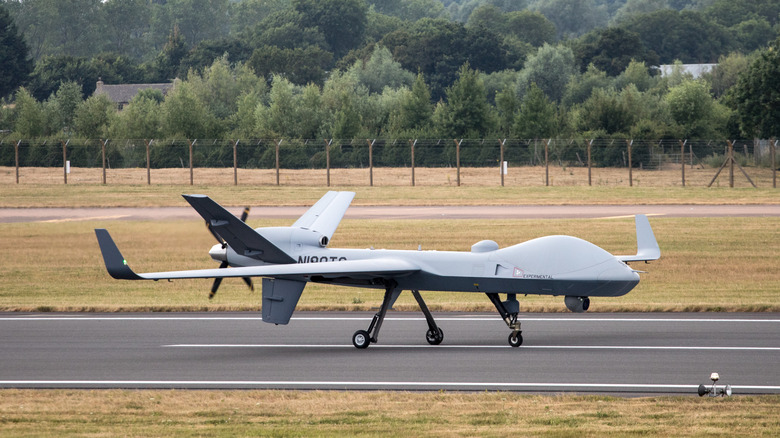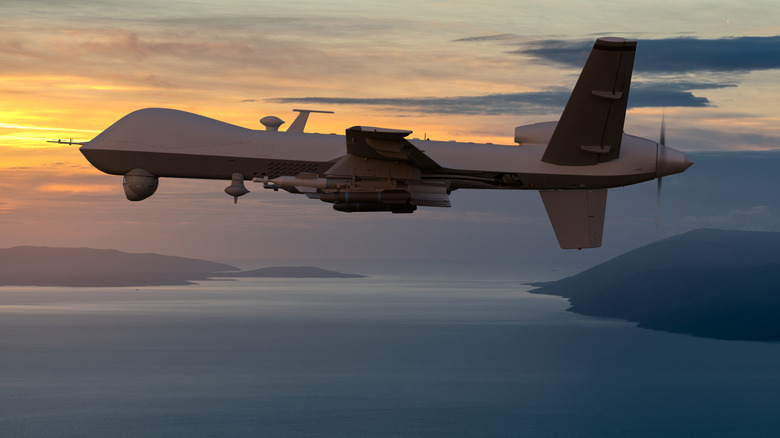US Military MQ-9B Drones Now Have Their Own Top Gun-Style Robot Wingmen
General Atomic Aeronautical Systems Inc (GA-ASI) recently announced its latest innovation in unmanned aviation technology. This breakthrough means that, for the first time, the company's MQ-9B military drone can now operate in tandem with its own "robot wingman" as a supporting character on missions. This represents a significant advancement for aerial drone deployment, even as modern warfare continues to evolve and employ unbelievably high-tech military weapons.
The support drone is dubbed PELE, short for Precision Exportable Launched Effect. Incidentally, the name is also inspired by the Hawaiian goddess of fire and volcanoes. PELE is a propeller-driven aerial platform with a 9-foot frame built around a 16 hp engine and a wingspan that stretches 11 feet. PELE was custom-designed to integrate with the MQ-9B drone. With a 575-mile mission range, PELE is able to support the MQ-9B on a variety of endurance missions, such as electronic intelligence gathering, aerial surveillance, and even strike missions. The MQ-9B drone can deploy one or multiple PELE units on a single mission, greatly expanding its operational reach and versatility. In addition to being air-launched, the PELE support drone can also be launched from ground-based systems, offering even more flexibility in how it can be packaged and deployed.
A formidable pairing on the battlefield
The key strategic advantage of integrating the PELE robot wingman with the MQ-9B drones lies primarily in enhancing platform survivability and expanding tactical options on missions. The MQ-9B has already proven its worth as a world-leading medium-altitude, long-endurance (MALE) remotely piloted aircraft system. Pairing it with PELE would make it even more potent, unlocking greater capabilities and amplifying its operational effectiveness.
The PELE unit can be launched into a high-risk zone to undertake tasks that would otherwise expose the high-value MQ-9B to significant threats. This tactical decoupling allows the MQ-9B to maintain a safe stand-off distance, preserving its operational longevity, while PELE extends intelligence, surveillance, and reconnaissance (ISR) reach deep into denied areas.
For instance, an MQ-9B drone can remain in international airspace, close to a hostile zone, and then unleash one or multiple PELE robot wingmen. The support drones carry a whole range of electro-optical/infrared (EO/IR) full-motion video sensors and other equipment that can be used to execute real-time surveillance, geo-locate air-defense systems, or conduct electronic warfare duties. Critical information gathered during these probe missions can then be transmitted in real-time to support units and used to plan follow-up missions, all without jeopardizing the MQ-9B drone, which can cost over $100 million per unit, depending on the add-on packages.
Unlocking a new phase of Unmanned Aerial Vehicle (UAV) operations
From rudimentary reconnaissance tools to highly sophisticated combat platforms, military drone technology has undergone a remarkable evolution. The high tech tools used in the Ukraine war demonstrate how technology is reshaping modern warfare. Initially employed for surveillance purposes, military drones have progressively integrated capabilities like fully autonomous navigation, electronic warfare, and even precision strikes deep in enemy territory. Now, the ability of drones to operate almost fully independently with dedicated "Top Gun"-style wingmen has potentially unlocked a revolutionary new layer of drone operations, even as drone manufacturers like GA-ASI continue to explore ever more complex operational ideologies.
Developing semi-autonomous aerial aircraft like PELE is actually part of a broader U.S. push towards advanced unmanned programs like Collaborative Combat Aircraft (CCA) and Manned-Unmanned Teaming concepts. These innovations continue to redraw the boundaries of unmanned military operations and hint at a transformative future where UAVs, like the MQ-9B, are more autonomous, adaptable, and significantly less perilous for high-value assets and human military personnel.


